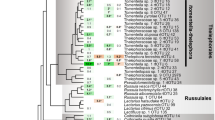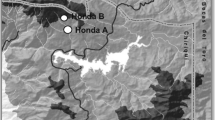Abstract
In most ectomycorrhizal (EM) community studies involving molecular identification methods there is a poor correspondence between fungi that appear dominant as sporocarps and those that appear dominant on EM roots and the species richness belowground is higher than that above ground. As a consequence, many fungi from root tip samples remain unidentified. In most studies, genetic data from multiple samples of an EM morphotype collected from various sampling locations are compared to genetic data from one to a few sporocarps of each species for identification purposes. The mismatch between above- and belowground species richness may be influenced by these different sampling efforts. To address this, intra-specific variation in the ITS region first investigated in Kårén et al. (1997) is revisited here, but at a spatial scale in which variation is expected to be low. Sporocarps were collected across a 7 km region of the Oregon Dunes National Recreation Area in western North America. ITS–RFLP data are presented for 3-18 sporocarps from each of 44 EM species in 18 genera. A total of 311 sporocarps were analyzed. Fifty-three ITS–RFLP types were observed. Of the 44 species, 38 (86% of total) yielded a single, species specific, RFLP type. No 2 species had the same RFLP type. Polymorphic ITS–RFLP types were observed in six species (14%). The following three species had two ITS-RFLP types with one type dominating: Inocybe lacera, Laccaria proxima, and Rhizopogon subcaerulescens. The following three species had three RFLP types with no type dominating: Laccaria laccata, Lactarius deliciosus, and Tricholoma flavovirens. A phylogenetic analysis of ITS sequences in Tricholoma revealed that two of the RFLP types in T. flavovirenswere apparently the result of intra-specific variation, while the third RFLP type was likely a cryptic species. All the other RFLP types observed in Tricholoma represented unique phylogenetic species. These results suggest that ITS–RFLP data from single samples (sporocarp or EM) are robust for characterizing most of the species at this scale. However, restriction endonucleases detect a limited amount of existing nucleotide variation and thus have limited value to detect cryptic species. Therefore, additional analyses of sequence data should be added to the RFLP matching technique to identify unknown RFLP types. These data also suggest that polymorphic RFLP types within species do not adequately explain the mismatch between above- and belowground views of EM species richness.
Similar content being viewed by others
References
Aanen D K, Kuyper T W, Boekhout T and Hoekstra R F 2000 Phylogenetic relationships in the genus Hebeloma based on ITS1 and 2 sequences, with special emphasis on the Hebeloma crustiliniforme complex. Mycologia 92, 269-281.
Agerer R 1987-1996 Colour Atlas of Ectomycorrhizae. Schwäbisch Gmünd: Einhorn-Verlag Eduard Dietenberger.
Agerer R, Kraigher H and Javornik B 1996 Identification of ectomycorrhizae of Hydnum rufescens on Norway spruce and the variability of the ITS region of H. rufescens and H. repandum (Basidiomycetes). Nova Hedwigia 63, 183-194.
Baura G, Szaro T M and Bruns T D 1992 Gastrosuillus laricinus is a recent derivative of Suillus grevillei: molecular evidence. Mycologia 84, 592-597.
Bessette A E, Bessette A R and Fischer D W 1997 Mushrooms of Northeastern North America. Syracuse University Press, Syracuse, New York, USA. 582p.
Bedry R, Baudrimont I, Deffieux G, Creppy G, Pomies J P, Dupon M, Gabinski C and Chapalain J C 2001 Wild-mushroom intoxication as a cause of rhabdomyolysis. N. Engl. J. Med. 345, 798-802.
Breitenbach J and Kränzlin F 1991 Fungi of Switzerland: Vol. 3. Mykologia Luzern. Luzern, Switzerland. 361 p.
Bruns T D, White T J and Taylor J W 1991 Fungal molecular systematics. Annu. Rev. Eco. Syst. 22, 525-264.
Dahlberg A, Jonsson L and Nylund J-E 1997 Species diversity and distribution of biomass above and below ground among ectomycorrhizal fungi in an old-growth Norway spruce forest in south Sweden. Can. J. Bot. 75, 1323-1335.
Eberhardt U, Oberwinkler F, Verbeken A, Rinaldi A C, Pacioni G and Comandini O 2000 Lactarius ectomycorrhizae on Abies alba: morphological description, molecular characterization, and taxonomic remarks. Mycologia 92, 860-873.
Eberhardt U, Walter L and Kottke I 1999 Molecular and morphological discrimination between Tylospora fibrillosa and Tylospora asterophora Mycorrhizae. Can. J. Bot. 77: 11-21.
Farmer D J and Sylvia D M 1998 Variation in the ribosomal DNA internal transcribed spacer of a diverse collection of ectomycorrhizal fungi. Mycol. Res. 102, 859-865.
Gardes M and Bruns T D 1996a Community structure of ectomycorrhizal fungi in a Pinus muricata forest: above-and below-ground views. Can. J. Bot. 74, 1572-1583.
Gardes M and Bruns T D 1996b ITS-RFLP matching for identification of fungi. Meth. Mol. Biol. 50, 177-186.
Gardes M, White T J, Fortin J A, Bruns T D and Taylor J W (1991) Identification of indigenous and introduced symbiotic in ectomycorrhizae by amplification of the nuclear and mitochondrial ribosomal DNA. Can. J. Bot. 69, 180-190.
Gehring C A, Theimer T C, Whitham T G and Keim P 1998 Ectomycorrhizal fungal community structure of pinyon pines growing in two environmental extremes. Ecology 79, 1562-1572.
Goodman D M, Durall D M, Trofymow J A and Berch S M, eds. 1996-1998 A Manual of Concise Descriptions of North American Ectomycorrhizae. Mycologue Publications and Canada-B.C. Forest Resource Development Agreement, Canadian Forest Service, Victoria, B.C.
Henrion B, Le Tacon F and Martin F 1992 Rapid identification of genetic variation of ectomycorrhizal fungi by amplification of ribosomal RNA genes. New Phytol. 122, 289-298.
Hesler L R and Smith A H 1979 North American species of Lactarius. University of Michigan Press. Ann Arbor, Michigan, USA. 841 p.
Horton T R and Bruns T D 2001 The molecular revolution in ectomycorrhizal ecology: peeking into the black-box. Mol. Ecol. 10, 1855-1871.
Ingleby K, Mason P A, Last F T and Fleming L V 1990 Identification of ectomycorrhizas. HMSO, London.
Jonsson L, Dahlberg A, Nilsson M-C, Kårén O and Zackrisson O 1999a Continuity of ectomycorrhizal fungi in self-regenerating boreal Pinus sylvestris forests studied by comparing mycobiont diversity on seedlings and mature trees. New Phytol. 142, 151-162.
Jonsson L, Dahlberg A, Nilsson M-C, Zackrisson O and Kårén O 1999b Ectomycorrhizal fungal communities in late-successional Swedish boreal forests, and their composition following wildfire. Mol. Ecol. 8, 205-215.
Kårén O, Hogberg N and Dahlberg A 1997 Inter-and intraspecific variation in the ITS region of rDNA of ectomycorrhizal fungi in Fennoscandia as detected by endonuclease analysis. New Phytol. 136, 313-325.
Luoma D L 1991 Annual changes in seasonal production of hypogeous sporocarps in Oregon Douglas-fir forests. In Conservation and Management of Native Plants and Fungi. Eds. T N Kaye, A Liston, R M Love, D L Luoma, R J Meinke and M V Wilson. pp 249-253. Native Plant Society of Oregon, Corvallis.
Mahmood S, Finlay R and Erland S 1999 Effects of repeated harvesting of forest residues on the ectomycorrhizal community in a Swedish spruce forest, New Phytol. 142, 557-585.
Mehmann B 1995 Coincidence between molecularly or morphologically classified ectomycorrhizal morphotypes and fruitbodies in a Spruce forest. Biotechnology of Ectomycorrhizae: Molecular Approaches. Eds. V P Stocchi, P Bonfante and M Nuti. pp 41-52. Plenum Press, London, UK.
Methven A S 1997 The Agaricales of California 10: Lactarius. Mad River Press, Eureka, California, USA. 78 pp.
Moser M 1983 Keys to Agarics and Boleti. Roger Phillips. London.
O'Dell T E, Ammarati J F and Schreiner E G 1999 Species richness and abundance of ectomycorrhizal basidiomycete sporocarps on a moisture gradient in the Tsuga heterophylla zone. Can. J. Bot. 77, 1699-1711.
Sawyer N A, Chambers S M and Cairney J W G 1999 Molecular investigation of genet distribution and genetic variation of Cortinarius rotundisporus in eastern Australian sclerophyll forests. New Phytol. 142, 561-568.
Shanks K M 1997 The Agaricales of California 11: Tricholomataceae II-Tricholoma. Mad River Press, Eureka California, USA., 22 p.
Smith S E and Read D J 1997 Mycorrhizal Symbioses 2nd ed., pp 605. London, Academic Press.
Swofford D L 2001 PAUP*: Phylogenetic Analysis Using Parsimony, Version 3.1.1. Computer program distributed by the Smithsonian Institution, Washington, DC.
White T J, Bruns T D, Lee S B and Taylor J W 1990 Amplification and direct sequencing of fungal ribosomal RNA genes for phylogenetics. In PCR Protocols: A Guide To Methods And Applications. Eds. M A Innis, D H Gelfand, J J Sninsky and T J White TJ. pp 315-322. Academic Press, London.
Author information
Authors and Affiliations
Rights and permissions
About this article
Cite this article
Horton, T.R. Molecular approaches to ectomycorrhizal diversity studies: variation in ITS at a local scale. Plant and Soil 244, 29–39 (2002). https://doi.org/10.1023/A:1020268020563
Issue Date:
DOI: https://doi.org/10.1023/A:1020268020563




